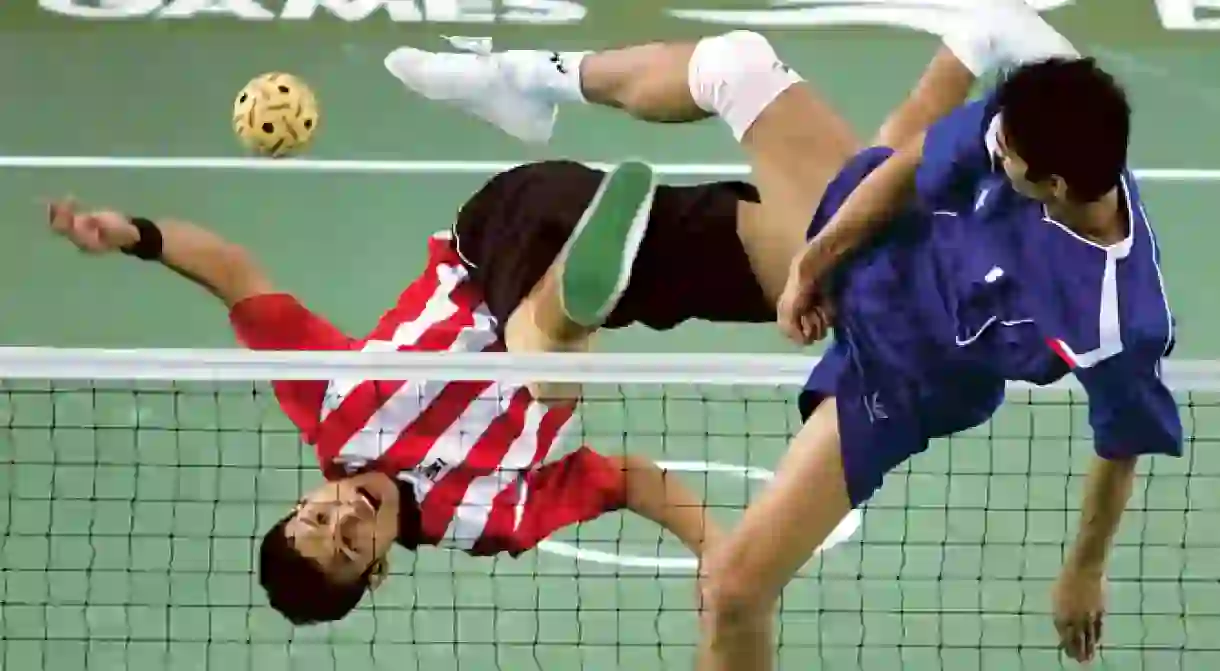Sepaktakraw: Malaysia's National Sport

Many sports demand everything from their participants but few require the extraordinary dexterity displayed by those who play sepaktakraw. We explore Malaysia’s national sport.
Introduction to Sepaktakraw
Sepaktakraw’s rules are similar to volleyball; the main difference is that participants can use any part of their body, except their hands and arms. Matches are played on courts similar in proportion to those of badminton, but with a grapefruit-sized ball that comes down with ferocious speeds of over 120 km/h (75 mph). Traditionally, hand-woven rattan balls – ‘takraw’ in Thai – were used, but the sport has adopted synthetic plastic in modern times, under the remit of various regional and international organisations. The ‘horse-kick’ serve and ‘sunback spike’, originating from Thailand, and the ‘cartwheel serve’, developed in Vietnam, are just three of the many spectacular moves that players use to smash the ball over the five-foot high net (1.5 metres).
History of Sepaktakraw
The origin of sepaktakraw is subject to fiery debate in Southeast Asia. According to the official website, versions of the game were played in Philippines, Brunei, Myanmar, Indonesia and Laos in the 11 century; Malaysia in the 15 century, as well as 16th-century Thailand. There is also speculation that trade with China, where an ancient military exercise vaguely resembling the game was played, first brought the sport to the region.

Sepaktakraw in Malaysian Culture
Malaysians cherish sepaktakraw as more than a sport – it’s a cultural tradition – and early evidence of the game features in the historical Malay Annals. In the fifteenth century, Raja Muhammad, a son and heir of Sultan Mansur was banished from the Malacca Sultanate at the request of Tun Perak. Tun Besar, Perak’s son, had been playing a primitive form of the sport when he hit Raja on the head with the rattan ball, knocking his headgear to the ground. He reacted by fatally stabbing Tun Besar. His subsequent expulsion from the city was negotiated by Tun Perak, who had restrained Besar’s kinsmen from seeking a treasonous revenge. This story is symbolic of the high passions that accompany the sport in Malaysian culture, although nowadays it’s a desire for medals, not blood, that the sport evokes.

Modern Development of Sepaktakraw
Over the last sixty years, the global appeal of sepaktakraw has increased and the sport is now played in more than 25 countries, across five continents. This began with the codification of a single set of English language rules in 1960 and continued with the first international competition at the 1965 Southeast Asian Peninsular Games in Malaysia. By 2008, the sport had been included in Beijing’s 1990 Asian Games, had seen its first female competition held during Thailand’s long-running 1997 King’s Cup and had become a component of the Asian Beach Games.
https://www.youtube.com/watch?v=gCcrkNMtem0
How to Play Sepaktakraw
There are a few variations of the sport, but the ‘regu’ format is the most prevalent model, used in International Sepaktakraw Federation (ISTAF) tournaments. Two teams of three take turns to serve, switching every three consecutive points. Each team has a designated server, feeder and striker, all with distinct tactical roles and skill sets. The teams battle it out on court over three sets, each of which includes the opportunity for one substitute and one 60-second tactical time-out per team. A team requires 21 points to win a set but if the score reaches 20–20, the first team to separate themselves from their opponents by two points, or reach 25, emerges victorious.
Sepaktakraw and the Olympics
In order for sepaktakraw to achieve Olympic status, it would have to meet the Olympic eligibility criteria, which include: tradition, universality, popularity and image, among others. Also considered are the proposed sport’s adaptability to TV, its appeal to young people and the cost of its venues. Sepaktakraw is played all over the world and badminton courts can be adapted to host matches so there are virtually no venue costs. The sport is drowning in Southeast Asian historical significance and its visual magnificence means that TV-worthiness should be no obstacle – it’s already televised in seventy countries. All things considered, it wouldn’t be surprising to see sepaktakraw on the Olympic roster in the future.
Attend a Sepaktakraw Match
Of all the annual sepaktakraw showcases across the globe, the ISTAF World Cup, the ISTAF SuperSeries, Malaysia’s Khir Johari Cup and the King’s Cup in Thailand are the most spectacular, drawing fans from all corners of the earth. In Europe, where the sport is still fledgling, admission to sepaktakraw venues can be free, like at the Swiss Open. Check your national sepaktakraw association’s website for more details.
https://www.youtube.com/watch?v=DcBN-NEYQ50













